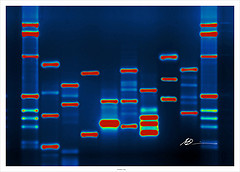
Photo by micahb37

I imagine this study of the genetic contribution to academic achievement will be of interest to many in higher education. As I see it, there are actually two related but distinct takeaways from this research. The first is that academic achievement (as measured by a standardized university entrance test; insert all the necessary caveats) is based on factors like “motivation, personality, [and] confidence” independent of intelligence/IQ. While hardly a surprising result, it’s a point that warrants reinforcement. As the story notes, for a long time IQ was the only metric investigated for this kind of study, which tended to shape thinking and conversations about education.
Second is that these traits can be attributed in large part to genetics. Remember, these are observational findings. It’s not that certain genes guarantee certain test scores no matter what; the results are only relevant within the context of the given academic environment. So we might image grouping students by age (as we do now), and also consider clustering by genetic traits. Not in a remedial fashion, but in acknowledgement that students with different combinations of traits like motivation or confidence might benefit from different learning strategies — just like personalized medicine hopes to use genetics to better match patients to therapies. Will we one day send our genome along with our transcripts and SAT scores when applying to college, in order to get a better fit between school and student? How do you think findings like these should be used?
Andy has worn many hats in his life. He knows this is a dreadfully clichéd notion, but since it is also literally true he uses it anyway. Among his current metaphorical hats: husband of one wife, father of two teenagers, reader of science fiction and science fact, enthusiast of contemporary symphonic music, and chief science officer. Previous metaphorical hats include: comp bio postdoc, molecular biology grad student, InterVarsity chapter president (that one came with a literal hat), music store clerk, house painter, and mosquito trapper. Among his more unique literal hats: British bobby, captain’s hats (of varying levels of authenticity) of several specific vessels, a deerstalker from 221B Baker St, and a railroad engineer’s cap. His monthly Science in Review is drawn from his weekly Science Corner posts — Wednesdays, 8am (Eastern) on the Emerging Scholars Network Blog. His book Faith across the Multiverse is available from Hendrickson.

Getting a better fit could result in a situation like GATTACA, which I used in class for many years to stimulate discussion on bioethical issues, choosing only ones with the ‘right’ genetics to succeed, or it could be used as I did, giving students a brief temperament analysis so they and I could better understand their personalities and learning styles so I could shape my teaching accordingly to give everyone the best chance to succeed. One year I did that with a class many other teachers labelled ‘dumb,’ and found the vast majority were very artistic, so I shifted the emphasis in the class to include far more drawing of observations, rather than verbal description, and they excelled. Should we seek to fit the student to the school or the teaching to the student? That is an ethical question, not a scientific one.
Gerald – Thanks for the comment. I think the approach you describe is a good model for how genetic information should be used, were we to reach the point that we can actually link specific gene variants to these educationally relevant traits. How to best make the necessary adjustments, without overburdening teachers, would probably require a fair bit of investigation, but it seems worth pursuing.